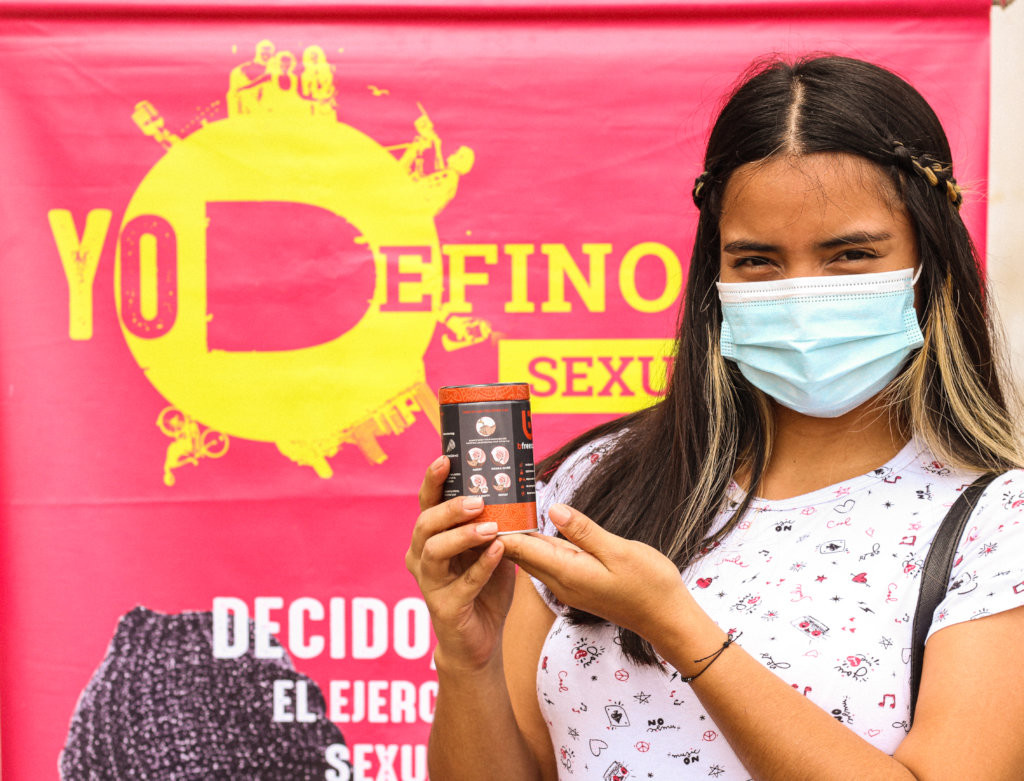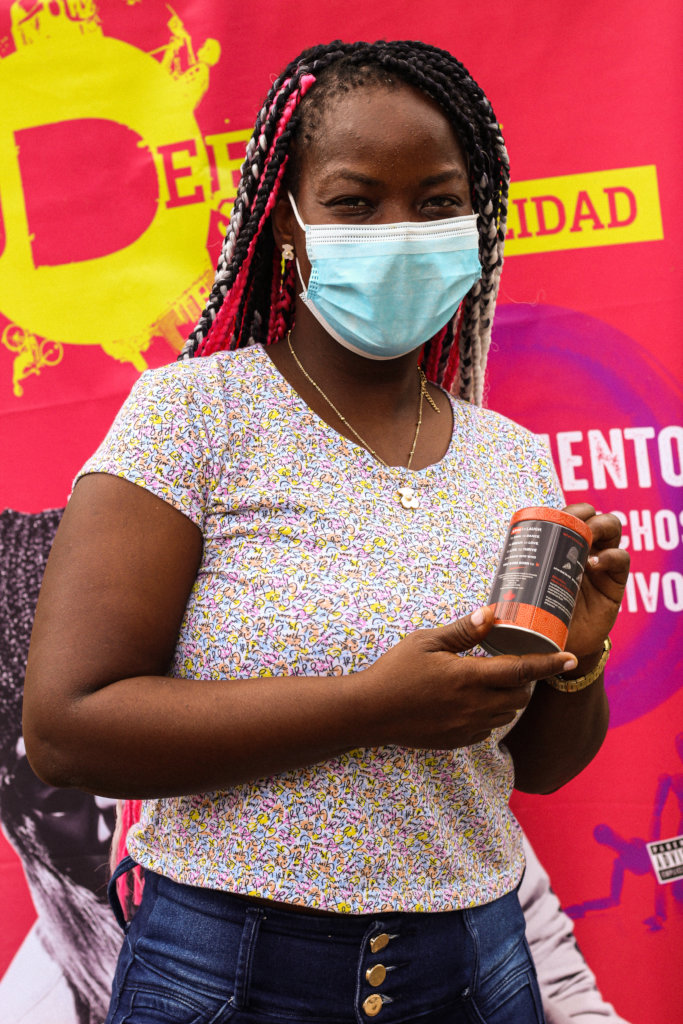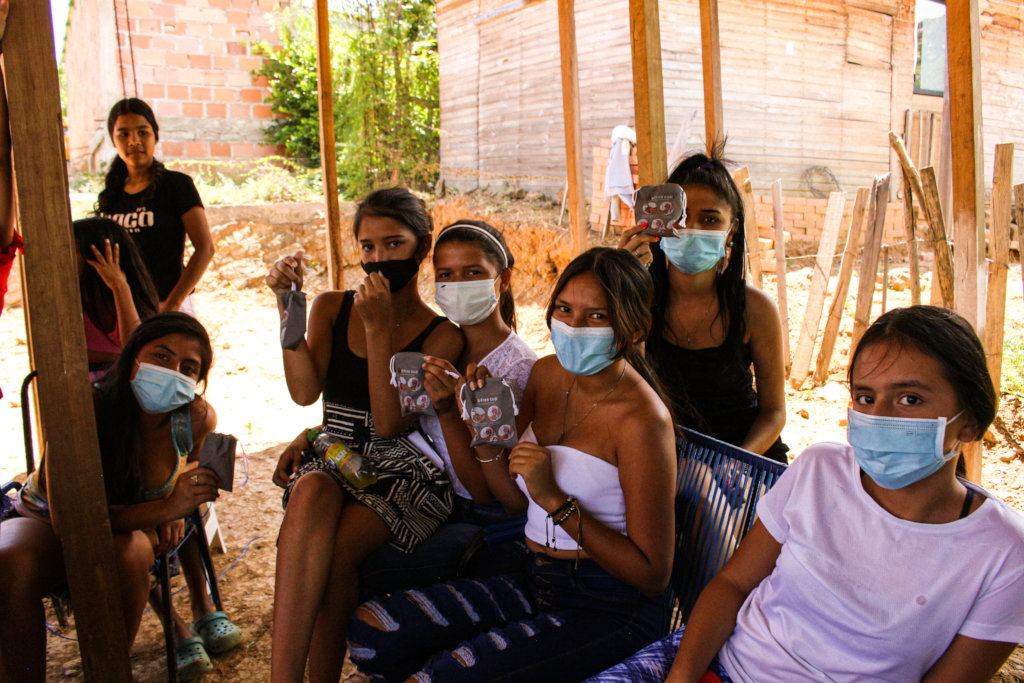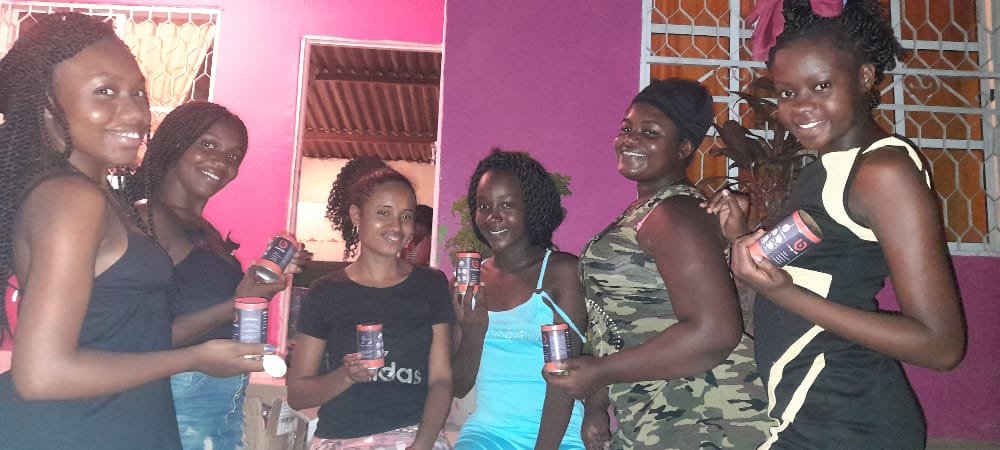By Maria Mercedes Vivas | Live your menstrual care
NARRATIVE REPORT FORMAT
1. GENERAL INFORMATION:
1. Name of organization: Fundación Oriéntame
2. Country: Colombia
3. Project year: 2021
4. Project name: SECOND PHASE - Live your menstrual care: Access to menstrual hygiene for girls and adolescents.
5. Reporting period: March 19 to April 20, 2021.
6. Date of preparation of the report: 21 April.
7. Name of the person in charge: Lady Alba.
2. PROJECT OBJECTIVES:
1. Improve access to menstrual health products for girls and adolescents in Cúcuta, Villa del Rosario, Los Patios and Palenque (Colombia).
2. Strengthen knowledge and self-care habits for girls and adolescents in Cúcuta, Villa del Rosario, Los Patios and Palenque (Colombia).
3. ACTIVITIES CARRIED OUT: During the period from March 19th to April 20th 2021, the planning process for project activities was outlined and the implementation of the activities began:
3.1 Develop educational content and didactic exercises for training sessions on menstrual care, hygiene and self-care.
1. The design of the virtual menstrual hygiene course was carried out, the contents were developed through 4 recorded and animated units: "knowing my body"; "my menstrual cycle, my rules"; "my hygiene and menstrual care", and "the menstrual cup as a great option".
2. Three informative and educational capsules on how to talk about menstruation and recognize different menstrual products were developed to invite adolescents to enroll in the virtual course.
3.2 Invite girls and adolescents to training activities on menstrual care and health, self-knowledge of the body. It had two components: The invitation to launch the project was widespread among different stakeholders, such as community leaders, institutional leaders and teachers, with the purpose of making the course available and promoting it among girls. We also directly invite girls and young people between 13 and 25 years old in Cúcuta, Villa del Rosario, Los Patios and Palenque as well as community leaders. The invitation was shared through different virtual media such as social networks, email, WhatsApp and phone calls. Invitation to register for the project: Three WhatsApp groups were created to share information and reminders of important dates with the participants, as well as the calendar of tutorials and any news related to the virtual course. The content of the course was developed according to their age for three groups: 13 and 15 years old, 15 and 17 years old, and 18 years and older. A total of 851 girls, adolescents, young people and leaders from Cucuta, Villa of the Rosary, Los Patios and Palenque showed interest in the project. The training had a virtual and a face-to-face components. A total of 376 young people enrolled in the virtual component, that focused on the knowledge and autonomy in self-care. A total of 441 adolescents and young women between 13 and 25 years old registered in the in- person workshop. In turn, 34 leaders, professionals and mothers registered to registered in the cycle of training in menstrual health.
3.3 Carry out a virtual training in menstrual care and health, focused on the self-knowledge of their body:
1. The virtual course started from March 19 to April 20, 2021. Each unit contained the following activities:
2. Let's learn together - introductory video of the topics to be discussed in each unit.
3. Fun facts - a PDF with important facts to consider.
4. Let’s clarify the questions: participate in the forum by asking questions or exploring a topic.
5. Let's chat to attend the virtual tutorial meetings (synchronous meeting) or to watch the prerecorded tutorial sessions.
6. What did you learn? – answer questions about the content studied in the unit.
7. Four synchronous tutorials were conducted after each unit to answer questions posed by participants in the forums, or to discuss a specific topic more deeply. Image Forum: Image of the virtual course:
8. A total of 117 people participated in the course, including high school and university students, teenagers, professionals and mothers who did not attend school and some others who were working.
3.4 Prepare the general concept for the campaign and graphic pieces on the use of the menstrual cup, as well as menstrual health. Seventeen graphic pieces were designed for the virtual course, emphasizing key aspects about the use of the menstrual cup, the concept of menstrual hygiene, the menstrual cycle, menstrual products and knowledge of our body. Graphic use of the cup piece: Graphic piece of the menstrual cycle:
3.5 Sensitization “Information capsules” on menstruation were published on social networks and WhatsApp groups. Messages were also posted from participants expressing their appreciation for the course, as well as sharing a drawing of their vulva. We collected some images, highlighting his creations and his messages to his vulva.
3.6 Identify the leaders of the municipalities 1. Community leaders, institutional leaders, teachers, parents from the municipalities of Cúcuta, Villa del Rosario, Los Patios and Palenque were convened, inviting them through telephone calls and / or emails to participate in the project. 2. A total of 34 people, including leaders, professionals and mothers, signed up to the project.
3.7 Develop a work plan with leaders
1. The cycle of training in menstrual health for leaders and mothers was carried out through five virtual sessions through Zoom: 1) Empower ourselves about our body -Menstrual cycle and female anatomy.
2) Management of menstruation - understanding our menstruation and being in harmony with it.
3) Knowing menstrual hygiene products-A personal choice.
4) Discovering the menstrual cup -An option to know our body.
5) Find the connection with our menstrual care- How do I take care of my magical universe?
2. Participation during the training cycle remained active with 14 people attending the first session. Ten people attended the entire cycle, and at the end, they received a certificate for their participation. Image of the training cycle session:
3.8 Conduct virtual talks on menstrual health, use and maintenance of the menstrual cup, myths about menstruation and the cup We included the correct use of the cup, good and bad practices of cup use, the myths and advantages of menstruation, the knowledge of the body, different definitions and menstrual practices in different contexts, in the four sessions developed within the training cycle of leaders.
3.9 Purchase of menstrual cups It was possible to purchase 800 menstrual cups of three different sizes, of high quality and at affordable prices, with the support of Fokus and Women’s Global Health Innovations.
4.0 Providing menstrual cups to girls and adolescents We mapped the municipalities of Cúcuta, Villa del Rosario, Los Patios and Palenque to identify strategic delivery points that were close to as many participants as possible. Five community leaders were in charge of delivering menstrual cups in Villa del Rosario, Los Patios, Cucuta and Palenque. Results:
4.1 The virtual course on menstrual health and care for girls and adolescents, and the training cycle for leaders/mothers/collectives
1. The virtual course strengthened the knowledge and self-care of 107 girls, adolescents, and young women between 13 and 25 years old from the municipalities of Cúcuta, Villa del Rosario, Los Patios and Palenque. We provide timely information on menstrual health management, through activities, readings, videos, participation forums and synchronous tutorials. We carried out four sessions to reinforce the content of the course.
2. Although 376 girls, young people and women enrolled in the course, during the telephone followup and messages, some of them expressed difficulties in having an Internet connection or mobile devices, and could not continue with the course. Because of that, 107 students completed the entire course virtually.
3. The virtual course and WhatsApp groups aimed at creating support networks among adolescent girls. It was possible to communicate and share different topics related to menstrual education. It was also possible for the participants to freely express and talk about different experiences, taboos and myths about menstruation and menstrual products in an environment free of judgment, generating a space of trust conductive to solving questions. Course results: Virtual TOTAL REGISTERED TO THE PROJECT Enrolled in the course # of Girls, young people and women enrolled in the course Started the course Completed the entire course Delivery of menstru al cups Registered GROUP 1 37 1 1 1 382 Registered GROUP 2 61 24 18 18 Registered GROUP 3 278 99 88 88 TOTAL 376 124 107 107 In person activities TOTAL SESSIONS REGISTERED FACE TO FACE GROUP REGISTERED Attended sessions Delivery of menstru al cups Registered GRUPO Villa del Rosario-Juan Frío (Let's talk) 140 23 23 441 Registered Cúcuta (Alejandra) 200 211 211 Registered Villa del Rosario (Las Mijas) 64 41 41 Palenque (Solvay) 37 21 21 TOTAL 441 296 296 Result training cycle leaders: REGISTERED Attended sessions Delivery of menstrual cups 34 9 9
4. Before the start of the course, 25 girls and adolescents (8 per group), who had started attending the course, were selected to apply the baseline to identify the conditions and knowledge base in terms of menstrual health management. At the end of the course, the same baseline was applied to the same 25 adolescents. However, only nine of them completed the data collection.
5. Before carrying out the training cycle, eight leaders and two mothers who were enrolled in the project were selected to apply the baseline. At the end of the cycle, the same baseline was applied to the 8 leaders and the 2 mothers.
4.2 Menstrual health awareness campaign for girls and adolescents
1. There was a positive response to the graphic pieces by leaders, professionals, teachers and adolescents shared on social networks and WhatsApp groups. They express interest in knowing the management of menstrual health, the menstrual cup and its proper use. They contribute by replicating this information in their WhatsApp status.
2. It was possible to attract the attention and participation of organizations such as the Corporación Mujer denuncia y muévete, Asociación de Mujeres Palenqueras Kasimba, LasMijas, Asociación Ser Negro es Más Sabroso, Fundación Hablemos, Women s Helth Innovation and Fokus.
3. The launching of the project was a key space to start implementing it. It allowed us to have direct contact with community leaders, professionals, and teachers interested in accompanying the educational process and the delivery of menstrual cups.
4.3. Menstrual cups given to adolescents for menstrual care
1. 403 girls and adolescents learned the correct use of the menstrual cup, through videos, graphic pieces, and meetings where the demonstration of the insertion and extraction process was carried out in a pelvic model. We clarifies many doubts and misconceptions about the menstrual cup, and provided information about its use.
2. A total of 412 menstrual cups were delivered: 9 of them to leaders who attended all the sessions of the training cycle, and 403 to girls and adolescents who completed the virtual course.
5. EVALUATION OF PROJECT PROGRESS:
5.1 Main achievements
1. A significant achievement was to maintain the attention of the leaders and mothers in the menstrual hygiene training cycle, from the beginning to the end of it, 34 participants were registered and 9 remained active throughout the process.
2. The invitation to sign up for the project had a major impact on social media, contact lists, emails, replicating and sharing the pieces, reaching more young people and organizations interested in accompanying the process of menstrual health management.
3. The attendance of adolescents in synchronous tutorials remained high, the average attendance per group from beginning to end was 20 adolescents, actively participating in the forum.
5.2 Challenges, barriers or obstacles faced and solution The difficulties with the internet connection, the lack of wideband and / or mobile devices was a major obstacle to develop the virtual course and to connect to the tutorials. Such connectivity issues prevented several participants from completing the course and getting their menstrual cup. In times of Covid-19 pandemic and mandatory shelter in place, it was a challenge to carry out all synchronous sessions virtually. Some topics were suitable for in-person sessions due to their big content.
Additionally, it was not possible for adolescents who did not have internet to access the content of the course in person, due to the high contagion and the restrictions of meetings in public spaces. However, an attempt was made to establish communication with a close relative to convey accurate information about the virtual course.
5.3 Lessons learned We must take into account the connectivity barriers for a project like this, since the attendance of the participants is something that we have less control. This leads us to consider an additional effort to achieve participation and coverage goals. We have learned that menstrual health management should continue to be addressed extensively, to offer safe and truthful information about menstruation, the advantages, and disadvantages of various menstrual products, and to increase the knowledge of the body. From that knowledge, we are aware of the power we have to make decisions about it, participate in safe sex and understand natural processes such as menstruation
Links:
By MARIA VIVAS | SECOND PHASE - Live your menstrual care
By Lady Alba | Coordinadora area de capacitacion y proyectos
Project reports on GlobalGiving are posted directly to globalgiving.org by Project Leaders as they are completed, generally every 3-4 months. To protect the integrity of these documents, GlobalGiving does not alter them; therefore you may find some language or formatting issues.
If you donate to this project or have donated to this project, you can receive an email when this project posts a report. You can also subscribe for reports without donating.
Support this important cause by creating a personalized fundraising page.
Start a Fundraiser



